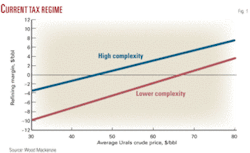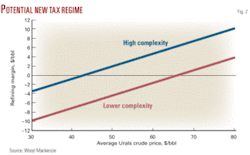Falling crude prices could upset the symmetry between duties on crude and products in Russia, potentially changing the incentives and actions of refiners there, according to a recent Refinery Evaluation Model Insight from Wood Mackenzie.
For a long time, Russia used an oil export duty to provide an incentive for domestic refiners to run crude, upgrade facilities, make products, and protect employment. This strategy enjoyed much success in the past, with Russia setting the duty level accordingly to encourage these behaviors.
Wood Mackenzie’s report, entitled “How will lower oil prices affect Russian refiners?”, examines the role of the export duty regime and implications of changes in crude price, duty, and transportation tariffs on four sample refineries—two on the coast, and two inland. The study considered how investment and behaviors would change with lower oil prices and a refining industry suffering from increasing uncertainty and falling margins.
Changes in Russia’s duty regime aim to encourage refiners to modernize existing capacity by increasing the incentive to produce light products for export while penalizing exports of feedstocks and fuel oil. Wood Mackenzie’s calculations, however, show that in the current low-crude-price environment, tax change benefits are unlikely to be sufficient to prevent run cuts from inland refiners due to the extent that transportation and fixed operating costs have affected margins.
This would affect European and other products markets if supplies from Russia did decline, prospectively reducing fuel oil and vacuum gas oil feedstocks and, to a lesser but potentially significant extent, reducing gas oil and diesel product deliveries.
According to the report, Western and Central European refiners would welcome any prospective reductions in Russian refinery utilization. Resulting reductions in fuel-oil exports would support straight-run fuel oil prices and assist European hydroskimming margins.
A lower supply of vacuum gas oil and straight-run fuel oil could also lead to increased feedstock costs for high-complexity refiners in Europe; this, however, may at least be partially offset by stronger crack spreads for gas oil and diesel, a result of reduced imports from Russia. Overall, this should support simple refining margins in Europe, likely to be under pressure due to lower product demand in the Atlantic Basin, the report said.
Another positive factor for European refiners would be any increased potential availability of Urals crude. Many refiners in Central Europe on the Druzhba pipeline have faced higher prices recently because the “Druzhba discount” has decreased.
Some Russian producers could find themselves in a position to negotiate higher crude prices. Overall, however, Wood Mackenzie is forecasting lower Russian production in 2010 than did the firm earlier this year. The point at which Transneft crude export capacity is exploited fully would mean any further exports by rail, with correspondingly lower netbacks, would potentially reduce domestic crude prices further.
Wood Mackenzie argues that domestic refiners reducing crude runs and logistics restricting crude exports is unlikely to be sustainable. If crude and products prices remain low, then it is possible that the government could be encouraged to reduce product export duties relative to crude duties to support crude runs and utilization, particularly inland.
Location plays a key role. Distance, and therefore costs, factor in. And any changes in rates for crude export via pipeline or rail will affect different refiners in different ways, reflecting differences in location and feedstock export logistics.
Russian product prices
Russian domestic product prices, particularly for gas oil, diesel, and high-sulfur fuel oil, have largely followed export price parity. Exports have become a key element of refiners’ strategy, with export duty a significant component of final price.
Historically, the export duty on products like fuel oil was set lower than the export duty on crude, resulting in an incentive for refiners to run crude and to maintain employment rather than to simply export raw crude.
Crude is exported mainly through the Transneft pipeline network, a 48,000-km system that handles more than 90% of total crude destined for both domestic and foreign markets. A relatively small proportion of crude goes by rail, often for segregation of premium quality.
Products are moved either by the Transneft pipeline network or by rail. Fuel oil is exported predominantly by rail; about 7 million tons/year are transported on inland waterways during the summer.
Wood Mackenzie estimates that product pipeline tariffs are roughly half the cost of rail freight. The variation in both rail and pipeline tariffs with crude and product prices is relatively low. As oil prices fall, therefore, there is a point at which the incentive to refine crude oil no longer offsets the incremental cost of transporting products to export markets compared to transporting and exporting crude. Refineries farthest from export points suffer the most because these sites generally incur higher transportation costs to move products to export markets.
With product prices reaching highs in July 2008, Wood Mackenzie estimated that product transportation costs accounted for 11% of the gross product worth (GPW) for a low-complexity inland refiner. By the beginning of December 2008, this had risen to 29%. In contrast, a low-complexity coastal refinery saw transportation costs rise to about 8% from 4% of GPW during the same period.
It has taken some time for the effects of the loss of the export duty incentive to have an effect. Reductions in domestic oil product prices have lagged the fall in international prices.
Until recently, Russian export duties were based on 2-month lagged oil prices; therefore, given the precipitous decline in crude oil prices during the fall of 2008, crude exports sometimes yielded negative returns. Consequently domestic crude prices fell further, bolstering refining margins.
Overall, the Russian market is now becoming much more fully exposed to the effect of sustained lower crude oil prices on refining profitability, according to the report.
Implications
For comparison, Wood Mackenzie modeled four refineries to calculate refining margins given different market situations. Included were a high-complexity refinery and a lower-complexity refinery close to ports and a higher-complexity and lower-complexity refinery inland. The high-complexity refinery located inland is in the Moscow area, the lower-complexity inland refinery is in the Volga-Urals region.
Wood Mackenzie obtained the yields from its Refinery Evaluation Model. The analysis assumed that all of the fuel oil and most of the gas oil production was exported, with an adjustment made to account for local sales of gasoline and naphtha.
More-complex refineries produce a greater proportion of higher-value, lighter products and have a higher GPW than less-complex refineries. For higher and lower-complexity coastal refineries, transportation costs rose, unsurprisingly, in identical fashion, to 8% from 4% during July to early December 2008, according to the report. In contrast, for a complex inland refinery, transportation costs rose to more than 17% from 7%.
Although downstream transport costs for refiners closest to export markets have doubled, these costs remain a significantly smaller proportion than those for inland refineries. Rates for inland refineries have risen by 2.5-3 times starting from a much higher base, resulting in a much more severe effect on profitability.
For refineries even farther inland than the two examples modeled, the effect is more acute. For a complex refinery in West Siberia, product transportation costs accounted for 11% of GPW in July and had risen to more than 32% in early December, according to the report.
This effect increases when crude and products prices fall. On a net-cash margin basis, Wood Mackenzie’s modeling shows that both inland refineries produced negative refining margins at the beginning of December and would likely consider cutting utilization.
Both the higher and lower-complexity coastal refiners had positive margins in early December, according to Wood Mackenzie’s model, but have seen margins fall considerably. Conversely, a complex refinery in Rotterdam would have generated a higher margin during the same time, which shows that Russian refineries were at a distinct disadvantage due to the increased proportion of logistical costs.
Current export duty regime
Fig. 1 shows relative break-even points for the inland refineries modeled. Wood Mackenzie calculated product prices using crack spreads from early December applied to varying crude prices. Export duty costs were adjusted according to the crude price using the current tax formulas for crude and products.
Given the current product export-duty regime, the more-complex inland refinery breaks even when the average CIF Urals price in northwestern Europe and Mediterranean is about $46/bbl; the less-complex inland refinery breaks even at about $67/bbl. This shows that the lower-complexity inland refinery operates at a significant loss and is likely to cut runs and the more-complex refinery would be under economic pressure to reduce output.
The break-even points, however, for coastal refineries are significantly lower, $40/bbl for the simpler of the two and $30/bbl for the more complex refiner. Most Russian refining capacity lies inland and is lower complexity; therefore, there are likely to be many inland refiners that have, or are considering, cutting runs in the current market environment.
The average Wood Mackenzie complexity index for refining capacity in Russia is 4.3, significantly lower than the European average of 6.5, as calculated by Wood Mackenzie’s Refinery Evaluation Model.
These calculations used current oil products export duty calculations. The formulas set the export duty for light products at about 70% of the crude export duty fee and the export duty for “dark” products (vacuum gas oil and fuel oil) at about 40% of the crude export duty fee.
The difference between the duty rates on different products historically supported simple and less-complex refiners delivering higher yields of dark products. It is possible that this differential could be removed and the export duty for all products subsequently become 54% of the crude export duty fee, according to the report.
New export-duty regime
The potential new regime, which includes a change to dues calculated monthly, would encourage refiners to invest in deeper refining of domestic crude and also to modernize refineries and produce higher-quality products. For the simplest refineries producing a high fuel-oil yield, the change would result in a higher tax burden, but for the refineries modeled the changes would be positive for refining margins. Higher-complexity refineries would benefit the most.
Fig. 2 shows the relative break-even points for each refinery type under the revised tax regime with all other costs unchanged.
In this scenario, break-even for the more-complex inland refinery is reduced $4/bbl to $42/bbl, with break-even for the less complex inland operator only $1/bbl less, at $66/bbl. Using early December 2008 crude and products prices, Wood Mackenzie calculated that the refining margin at more complex refineries would be about $1/bbl higher under the new regime, with the less-complex refineries achieving a margin just $0.20/bbl higher under the same circumstances.




